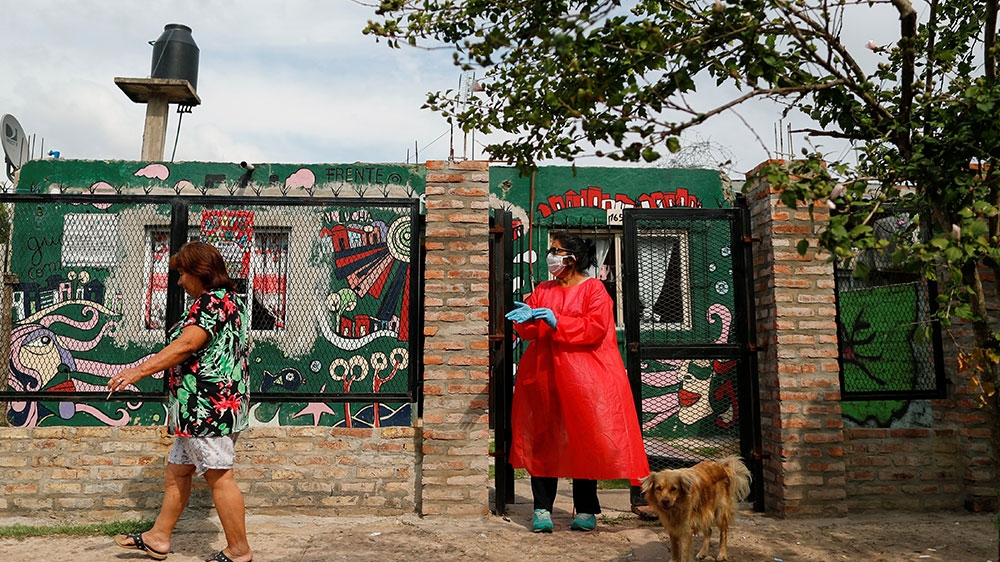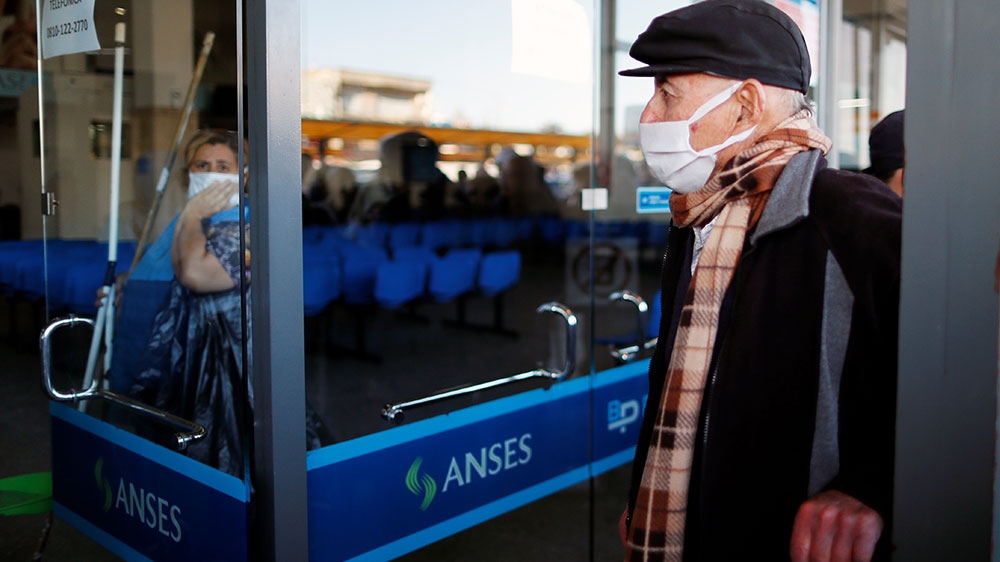Argentina’s poorest barrios caught between coronavirus and hunger
The COVID-19 pandemic exposes in crude terms Argentina’s deep socioeconomic fault lines.

Buenos Aires, Argentina – Even before the alarm about the novel coronavirus set in, a group of 36 mothers in one of Buenos Aires’s largest and poorest barrios, or neighbourhoods, had made it their mission to educate their neighbours about the viruses that were lurking.
Dengue season was upon them, so they set up tables on the busiest roads of Villa 21-24, holding workshops about how to protect each other. Their messaging shifted to the novel coronavirus as awareness and fear over the pandemic spread. When the government declared a mandatory quarantine starting on March 20 to try to contain the infectious disease, the mothers walked each of the 24 blocks of their neighbourhood, personally delivering preventive advice and handing out bars of soap they had cut into fours, so there would be enough to go around.
Keep reading
list of 3 itemsArgentina’s lockdown: More people out of work and food
Argentina sees at least 6 femicides during coronavirus quarantine
“The 36 mothers, we’re going crazy trying to make sure that it doesn’t happen in our barrio,” said Mayra Ledezma, who runs a soup kitchen.
“We said that if someone is infected here, we’re done. We’re going to fall like flies. If it happens, it’s not going to be one, two or three at a time – it’s going to be by the dozen,” said the 36-year-old mother of five.

Argentina is in full-blown emergency response mode because of COVID-19. The number of reported cases sat at more than 2,150 as of Sunday morning, covering most of the country. A least 90 people have died.
The later arrival of the virus on the continent and a view of how it developed in other parts of the world has given countries in South America precious time to try to bolster fragmented and fragile healthcare systems. Argentine President Alberto Fernandez imposed a nation-wide quarantine for everyone except essential services 17 days after the first confirmed case. The result: a dramatic drop in movement on the street and a brusque halt to wide swaths of the economy. The measures so far have received overwhelming public support in the country of 45 million, and high levels of compliance, although tens of thousands of people now face criminal charges for violating the quarantine.
The quarantine has been extended twice since it was initially announced – first to April 13, and most recently to April 26. Fernandez has made repeated reference to impoverished segments of society, promising all the food and resources necessary to live out the emergency. In the poorest settlements, the government is trying to enforce a “community quarantine” – no one leaves the neighbourhood and no one from the outside comes in, as a sort of protective shield. On Friday, the president cautioned that it is too early to say if the approach is working.
Poor neighbourhoods brace for impact
Living through a quarantine is not easy in general. But it is especially gruelling and practically impossible in working-class or poverty-stricken settlements, where people may live in dilapidated housing, many family members to a room, sometimes without running water or refrigerators.
The pandemic has exposed in crude terms the deep socioeconomic fault lines that exist in Argentina, that already has high levels of inequality, and was in the middle of a painful recession. Some eight million Argentines relied on food assistance before the pandemic. Now, the government reports, it is 11 million. Nearly half of the workforce makes its living in the informal sector, according to the Catholic University of Argentina, selling goods on the street, cleaning houses, mending clothes and anything in between. Thousands of people live on the street in urban centres.
The precarious life is clearly visible in the densely populated ring of municipalities around the capital of Buenos Aires, known as the conurbano, which has poverty levels that exceed the national rate of 36 percent. People here scrape by to survive on a good day. Now, they are caught between the menace of a virus outdoors, and the menace of going hungry indoors. Soup kitchens, which are essential services, have seen their numbers skyrocket.

These are also neighbourhoods that are battling other health problems such as measles and tuberculosis. Often, the poorest settlements are located on polluted lands, near toxic rivers or landfills that cause respiratory difficulties among locals. Many use neighbourhood health centres for general medical attention, but access to healthcare for more serious ailments varies widely from municipality to municipality. Argentina’s healthcare system is broadly divided into public, private and the social security sector, with the lowest earners relying on the less equipped public system.
“There’s a certain resignation,” said Silvia Saravia, a teacher who lives in the conurbano municipality of San Martin and is a leader with the community group Barrios de Pie. Resignation that the novel coronavirus will arrive and when it does, “it will be rough, because everything is rough here”.
“I think the virus would die as soon as you stepped in puddles of water on the road,” she half-joked, to illustrate the level of toxicity that people cohabitate with. “It’s a reality that is very different from the one that is being shown.”
A group of Catholic priests, known in Argentina as the “curas villeros” – or “priests of the slums” because they live out their mission among the poor – met President Fernandez to talk about the challenges facing their communities. They have expressed concern about the elderly living rough, and have turned abandoned buildings into makeshift shelters for those who need isolation.
“At this time of pandemic there are two main problems in these communities, which is to stay at home, and clean your hands with frequency,” said Dr Leonel Tesler, a public health doctor and director of the Department of Science and Health at Jose C Paz National University, in the conurbano. “In houses of that precarity, life takes place outside, in the neighbourhood, and the house ends up being a transitory place,” he said. “And it could become dangerous when you think about the likelihood of spreading an infectious disease like COVID-19 or tuberculosis around.”
He added, “If you don’t have potable water” washing your hands is “very complicated.”
Government response
The economics make the situation even more difficult.
“If you depend on daily work to eat, and you can’t work, and you can’t eat, that’s a desperate situation, which makes any measure of isolation unsustainable,” said Tesler. “It’s not that they’re more exposed to the coronavirus, but it’s going to be more difficult to contain the coronavirus in general if people are circulating everywhere.”
The cash-strapped government says it is doing everything it can to ensure that does not happen. It has boosted child subsidies, issued a bonus for low earning pensioners, and a 10,000 peso payment (about $150) for independent contractors, or those who work in the informal economy. More than $30 million has been allocated to food assistance alone, with national, provincial and municipal authorities mobilising armies of people to bolster public kitchens. Social, religious and business groups have partnered to deliver boxes of food to more than two million people in Buenos Aires and the surrounding area. The government has also added hundreds of intensive care beds to the public system, and thousands of beds for those who need to be isolated with a less severe form of the disease.
“You don’t need to be a doctor to expect that the conurbano, with its population density, is going to be hit hard by the pandemic,” says Sergio Berni, security minister in the province of Buenos Aires. Officials are well aware that it’s “practically impossible” to adhere to household isolation, he told Radio Perfil recently, which is why they have focused their efforts on the most vulnerable and a community quarantine.

Graciela Noblecilla runs a soup kitchen in Avellaneda, a large district to the south of Buenos Aires separated from the city by the polluted Matanza Riachuelo River. It is work she does with “great joy” despite the potential exposure to the virus. She says the main concern is stock. She has been handing out bags of rations, rather than filling up plastic containers with meals, because that’s what people need – people like Luis Carmelo Alvez Diaz, a 50-year-old who earns a living as a repairman.
“I don’t think we’re going to make it to next week,” said Diaz early in the quarantine. He lives with his family in Sarandi, a municipality within Avellaneda, and also helps provide for a daughter who has children of her own.
“We’ll have to see what happens when things run out. Because if I go out to work, the police will detain me and take me to jail.”
Ledezma says residents of Villa 21-24 were tucked away the first week of the quarantine, but by the second week more people ventured out, “desperate” to find a way to make ends meet. She has not heard of any COVID-19 infections in her neighbourhood to date.
But she is obviously worried. Like many of the 36 mothers who are raising children on their own, she has lost the extra cash she used to make as a seamstress. And the bakery the mothers operate to raise funds for the lunchroom is at a standstill.
“There’s more people coming to us, asking for the little food that we can make,” she said.
“People that would have never wanted to come to a lunchroom, because they work, both mother and father, and they usually earn enough to make it to the end of the month,” she said. Now, they have no choice.